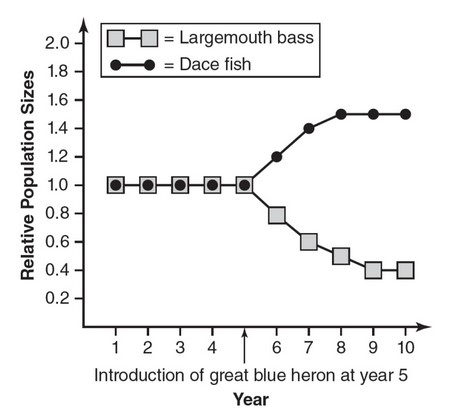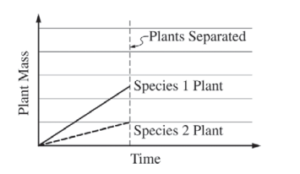Question
On an island north of the Arctic Circle, the Arctic fox preys upon puffins, and puffins consume Arctic grass.
(a) Identify the trophic levels to which the Arctic fox, puffin, and Arctic grass belong.
(b) Explain why the number of Arctic foxes on this island will most likely be less than the number of puffins in a healthy ecosystem.
(c) Predict the effect that the elimination of all Arctic foxes on this island would have on the puffins and Arctic grass.
(d) Justify your prediction from part (c).
▶️Answer/Explanation
Ans:
(a) The Arctic fox is a secondary consumer. The puffin is a primary
consumer. The Arctic grass is a producer.
(b) On average, only about 10% of the energy is available to the next
trophic level. So the number of puffins must exceed the number of
Arctic foxes or else the Arctic foxes would not be able to meet their
energy needs.
(c) The elimination of all Arctic foxes would increase the number of
puffins and decrease the density of the Arctic grass population.
(d) Since Arctic foxes prey on puffins, the elimination of the Arctic
foxes would increase the number of puffins. Since puffins consume
the Arctic grass, this increase in puffins would decrease the density
of the Arctic grass on the island.
Question
Largemouth bass (Micropterus salmoides) eat dace fish (Leuciscus leuciscus). Dace fish eat daphnia. Daphnia eat algae in the lake. The
number of largemouth bass and dace fish in a lake are recorded over a 10-year period. At year 5, great blue herons (Ardea Herodias) are
introduced to the lake. Great blue herons feed on young largemouth bass. The following graph shows the data regarding the relative
population sizes of the largemouth bass and dace fish over the 10-year period.
(a) Describe the trophic level of the dace fish in this ecosystem.
(b) Identify the independent variable and the dependent variable in this experiment.
(c) Analyze the data to determine the effect of the introduction of great blue herons on the population sizes of the largemouth bass and the dace fish.
(d) Predict the effect of the introduction of the great blue herons on the algae density in the lake. Justify your prediction.
▶️Answer/Explanation
Ans:
(a) The dace fish are secondary consumers because they eat daphnia,
which are primary consumers (that eat algae, which are the
producers). Dace fish are also the prey of the largemouth bass.
(b) The independent variable is the introduction of the great blue
herons. The dependent variable is the relative population sizes of
the largemouth bass and the dace fish.
(c) The introduction of the great blue herons reduced the relative
population size of the largemouth bass by about 40% and increased
the relative population size of the dace fish by about 40%. This is
because the great blue herons fed on the largemouth bass, reducing
their numbers. As a result of this decrease in largemouth bass, the
number of dace fish increased since there were no longer as many
predators (largemouth bass) to contend with.
(d) The algae density in the lake would increase. This is because algae
are consumed by daphnia and daphnia are consumed by dace fish.
If the numbers of dace fish increase (following the introduction of
the great blue herons), more daphnia will be consumed and there
will be fewer daphnia to consume the algae. Thus, the algae density
in the lake will increase.

Question:
The graph above shows the mass of plants from two different species over time. The plants grew while attached to each other. The plants were separated at the time indicated by the vertical line in the graph.
Using template 1, graph the predicted shape of the plant-mass lines after separation of the two plants if the plants were in an obligate mutualistic relationship. On template 2, graph the predicted shape of the plant-mass lines if the species 2 plant was a parasite of the species 1 plant. Justify each of your predictions.

▶️Answer/Explanation
Ans:

If both plant species 1 and 2 had an obligate mutualism relationship, they would need the other to survive, so they would both die out when separated. If plant species 2 was a parasite of plant species 1, then the species 2 plant would be harmful to the species 1 plant but need it to survive, so the species 2 plant would die out due to a lack of a host while the species 1 plant would thrive without the harmful parasite if the two plants were separated.
